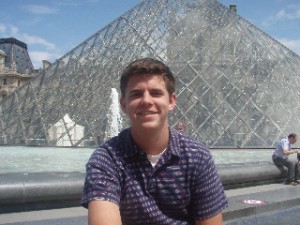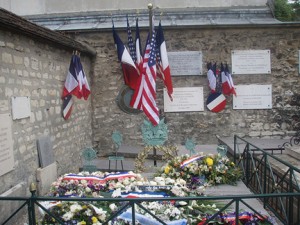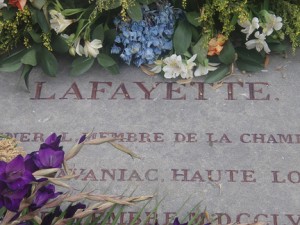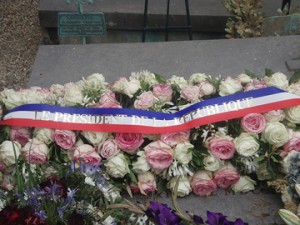By Matt Mezger ’13

Matt Mezger '13 in Paris, France
This past summer I spent six weeks studying in Paris, through a program sponsored by New York University and affiliated with Lafayette College.
View and share more photos in Flickr
I lived in a residence occupied by students in the study program in which I was involved and with students from all across the European continent who had internships in the city.
Our residence was two blocks away from the old Bastille prison. Although the prison no longer stands, it was very moving to be so close to the origin of the French Revolution where so many Frenchmen lost their lives for the cause of freedom. I commuted to my classes daily on the metro and witnessed so many facets of French culture — everything from the street performers, to mothers with their children, commuters to work, and the occasional homeless person. I took classes in a building with a view of the Eiffel Tower in the 16th arrondissement (the name of districts in Paris). My courses were taught in French: One was focused on advanced grammar and the other on an in-depth look at French culture and current events in French society. The second was especially interesting because the events of the Dominique Strauss-Kahn affair were developing simultaneously.

Grave of the Marquis de Lafayette, Paris
In Paris, I visited le Louvre, la tour Eiffel, la Cathédrale de Notre-Dame, l’Arc de Triumph, etc. In addition to those famous sites, I also traveled throughout France — each region and department are so different from one another. Our group went to see Omaha Beach, one of the American landing sites for D-Day, Montpelier, and the Loire Valley to see the various châteaux along the Loire River.
Seeing the grave of the Marquis de Lafayette in Picpus Cemetery was quite a moving experience. As I first walked into the cemetery where the Marquis rests, I was quite happy to see a common sight from home: the American flag. Seeing that flag there reminded me of how Americans have had just the same amount of impact on the French as the French did on Americans.

Tombstone on grave of the Marquis de Lafayette; floral tributes placed on July 4th each year
Seeing his grave had a twofold meaning for me. As an American, his tombstone represented a young courageous man who came out of his own free will to fight for the freedoms that the American Revolution embodied. As a student of Lafayette College, seeing his tombstone represented the entire College as a whole.
Lafayette College is named in honor of the Marquis because of the qualities that he had, and his grave represents all that Lafayette College stands for and what we strive to accomplish. The Marquis dedicated his life to make sure that every individual has the right to speak his or her mind regardless of race, ethnicity, gender, or creed. And I am proud that these are some of the very things that Lafayette College does, following the example of the Marquis.

Flowers from the president of France
Matt Mezger ’13 (Mount Bethel, Pa.) is pursuing a double major in history and government & law and foreign language. A resident of the Arts Houses, he is vice president of the Arts Society.




3 Comments
Thank you for your article. I grew up in Detroit (or D’etroit) and always had a fasination with Lafayette. A major street is named for him there. Before my last trip to France I studied up on him and found out just how important he was. I was able to visit his grave on that visit and will be going again this month. He had great ideas and ideals which we are still working hard to achieve….still a long way to go. Thank you
Sherry
Hello Matt,
What a great write-up with photos to boot! The Marquis was a great young man! It’s amazing how most friends and acquaintances I know (I’m in Chattanooga,TN +/- 25 miles from Lafayette,GA) have absolutely NO IDEA who he was! An enlightened, courageous, free-thinker and a great guerrilla fighter also. Thanks for the article and photos!
Regards,
Charlie Patterson
That was great! Thanks so much for sharing, Matt!
Comments are closed.